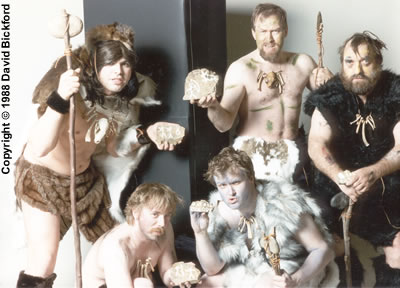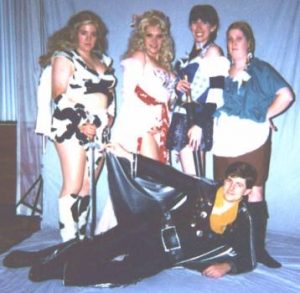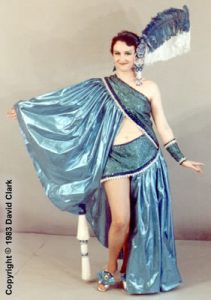CC06-H-01: The Mask of [the Red] Death
Competition Staff & Rules
Historical Masquerade Rules and Divisions
Historical Reproduction Masquerade Staff:
- Masquerades: Robin Schindler*
- Master of Ceremonies: Carl “Conrad” Cipra
- Presentation Judges: Victoria Ridenour, Aurie Bradley, Mela Hoyt-Hedon
Rules:
We hope these rules will clarify the intent of the Historical Masquerade. Our ultimate goal is to bestow recognition for the artistry that is the renowned hallmark of the Costume Con Historical Masquerade.
COMPETITION GUIDELINES:
1. Entry forms will be available at the convention registration table for you to fill out and return as soon as possible. Registration will close at 12:00 (noon) Sunday.
2. When you turn in your form, you may also turn in a cassette you wish to be played during your presentation. You will also be assigned an arrival time prior to the masquerade for pre-judging.
3. Tech rehearsal is available for those who wish it or who have any special lighting/audio requirements from 4:00pm to
5:00pm Sunday.
4. The historical masquerade itself starts at 8:00p.m. on Sunday. You should arrive at the green room at or prior to your assigned arrival time with all your documentation for pre-judging.
DIVISIONS:
To protect against uneven competition…
Novice: A person with no previous costume award at any serious competition; a first-timer in historical costume competition who may have experience in another costuming field.
Journeyman: A costumer who has won major awards in another field of costuming, but little or no experience in Historical Costuming; someone who has taken a novice award at a previous Costume Con Historical Masquerade; a historical costumer with no professional or major awards in previous historical masquerades.
Master: Historical costuming experience, professional jobs; someone who has taken at least 3 awards at historical
competitions.
CATEGORIES:
The Historical Masquerade will include, but Is not limited to, the following categories. None of these categories will compete against each other, none will be favored; all categories are eligible for Best of Show. Within each category, you will be judged according to the following criteria (as applicable).
Historical Reproductions: Carefully documented and researched, patterned, and sewn, then presented with period mannerisms for the total effect — a piece of living history, ranging from the menial worker to the nobility.
Historical Interpretations: These costumes are not being approached as reproduction clothing, but rather as imaginative spin-offs based on a historical premise. In the past, this has ranged from Beardsley and Mucha art to wild west scenarios. This category will be judged on overall historisty, including presentation.
Movie Reproductions: A rich source for costumers that wish to showcase their technical skills. Details such as Hair, Make-up, and construction technique for the films production date are of great importance!
In addition, we are establishing 3 highlighted sub-categories to promote expression and presentation in areas that are too often lacking in serious competition. This is a specific challenge.
Underpinnings: We recognize the fact that period underpinnings are an art all to themselves. Therefore, we are having a special award to acknowledge excellence in this area.
Tailoring: For men’s AND women’s clothing, including suits, uniforms, riding habits, coats, etc. that are tailored.
Ethnic: National costume from the festive to the primitive; Folk clothing with an international flavor. Essentially a deflection away from the cosmopolitan upper-class European style, this award covers the range of dress as divergent as American Plains Indian to the Chinese Opera.
JUDGING CRITERIA:
In picking judges and setting the criteria, we have consulted experts in many fields of historic costuming. Each entry will be judged on its own merits, within its own division.
Documentation: This is both important to entrant and judge alike. An esoteric entry, from a less popular era or country may need to supply basic information to receive the recognition it deserves.
Creativity: Historical costuming has its own foundation for interpretive spin-offs. The goal here is to remain consistent to the period while still creating an original design.
Authenticity: Reproductions of clothing striving for accuracy will be carefully examined. However, we will not judge fabric content, and will accept synthetics if they accurately represent the real fabric. Accessories and underpinnings will be judged on how they add to the overall look of the creation. The object of this category is the over-all look, not how much it costs. Movie Reproductions should be true to the cinematic era, and Interpretive categories need not be judged from the skin out.
Workmanship: This applies to any entry. Quality is quality, no matter the category, and a beautiful job deserves recognition. The following areas will be used to judge this criteria: technical (seam finishing, neatness) fit, handling of fabric, construction details (interfacing, pleating details, etc.).
Complexity: This applies to the scope of the project attempted, rather than the workmanship. The following areas are used as guidelines for this: scope of project, variety of techniques used, difficulty of techniques attempted, extent of original patterns used.
Presentation: A beautiful costume will fall short if it is not presented correctly, and with a certain amount of showmanship, confidence, and flair. Many past entrants have generated lavish choreography that impressed both judges and audience alike. Your presentation should not take longer than 90 seconds. If you have over 3 people in your presentation, youmay add another 60 seconds. Presentations running longer than the allotted time will be marked down. Also note that you do not have to use all of your allotted timet
Over All Observation: You will be scored on how well all of these separate elements work together, the Total Picture.
FINAL COMMENTS:
In the organization of these guidelines we have built heavily on the past labors of previous events and directors, we thank them for their experience and their expertise.

![CC06-H-01: The Mask of [the Red] Death CC06-H-01: The Mask of [the Red] Death](https://www.costume-con.org/wp-content/CC-VisualArchive/CC06/CC06-H/CC06-H-01.jpg)


